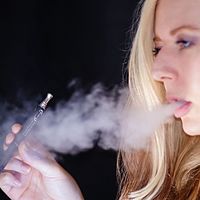
Photo from wikipedia
Abstract Wildfire smoke aerosols, once emitted, can transport over long distances and affect surface air quality in downwind regions. In New York State (NYS), fine particulate matter (PM2.5) concentration continues… Click to show full abstract
Abstract Wildfire smoke aerosols, once emitted, can transport over long distances and affect surface air quality in downwind regions. In New York State (NYS), fine particulate matter (PM2.5) concentration continues to decrease due to anthropogenic emission reductions and regulatory initiatives in recent years. Smoke aerosols, however, are projected to increase, making them the dominant source of PM2.5. Thus, the influences of smoke aerosols could become more important in the future. In this study, the long-range transport of smoke aerosols, and their impacts on local air quality over NYS in mid-August 2018 were investigated using satellite measurements, ground-based networks, and model products. Satellite measurements showed extensive fire activities over the northwestern United States (US) during August 8th – 10th. Air quality monitoring sites in NYS reported a threefold increase in average PM2.5 concentration (from 8.4 ± 3.4 μg m−3 to 24.8 ± 4.0 μg m−3) on August 15th – 16th, while the ground-based profiler network detected aerosol layers at 2–5 km across the state. Analysis of backward trajectories revealed that the plumes originated from wildfires, transported through southern Canada and arrived at the east coast during a period of 5–7 days. The increased PM2.5 in NYS can be attributed to boundary layer entrainment and vertical mixing of the aloft transported smoke aerosols down to the surface. The NYS mesoscale weather network (NYSM), which is originally designed for severe weather monitoring, demonstrate the capability to probe the lower atmosphere and provide the vertical extent information of air pollutants.
Journal Title: Atmospheric Environment
Year Published: 2020
Link to full text (if available)
Share on Social Media: Sign Up to like & get
recommendations!